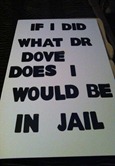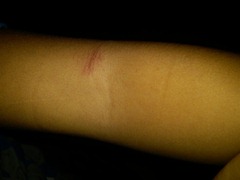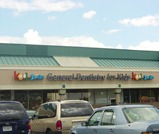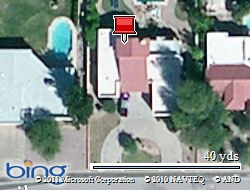Many dental restraints for young patients are being phased out
BY KELLIE SCHMITT, Californian staff writer
kschmitt@bakersfield.com | Monday, Aug 29 2011 08:03 PM
Last Updated Monday, Aug 29 2011 08:53 PM
As critics of a local dentist who frequently restrains his young patients grew in size and strength Monday, experts said the practice of routinely using a so-called papoose board is being phased out.
The allegations against Dr. Edward Dove center on injuries such as slaps and scratches that reportedly occurred while the children were restrained with Velcro straps, under partial sedation, and while their parents were not allowed in the room.
A representative from Dove's office said staff had been instructed not to talk to the media, and Dove did not return a call Monday. In a prior interview, Dove, whose record is free of disciplinary action, denied allegations of slapping any patients, and said he offered good care to thousands of children.
Using a papoose board and keeping parents out of the operating room aren't necessarily problematic, but pediatric dentistry experts say children should not be injured in the restraining process.
"If the kid thrusts through the whole procedure and cries vociferously, they can come out of a procedure with their face red," said Dr. Ray Stewart, executive director of the California Society of Pediatric Dentistry. "But in terms of scrapes and scratches, no. It's a violation of ethics, and the law and it clearly crosses the line."
GROWING ALLEGATIONS
Last week, Bakersfield resident Chris Cook was angry about Dove's treatment during his child's tooth extraction. He launched a Facebook site titled "I Hate Dr. Dove of Bakersfield," which has grown to more than 400 members.
Before his 5-year-old's extraction, the child threw up some of his oral sedative, Cook said. During the procedure, which Cook was not permitted to watch, his son urinated on himself. Cook alleges that his child, who was restrained with the papoose board, was not numb, and should not have been operated on.
On that Facebook page, other parents have reported similar incidents involving Dove's care. Cook has created a document on that site listing 21 people who allege mistreatment, many of whom say they're planning to report the claims to the Dental Board of California. Some members posted pictures of facial scratches they say resulted from their child's visit to Dove.
Cook, who said he's also "speechless and dumfounded" that Dove described his children's dental history to the media, organized a protest Monday in front of the dentist's Union Avenue office.
Protester Carol Webb said her daughter, then 3, needed dental work two years ago. Webb wasn't permitted in the back room but heard a "blood curdling scream." Her daughter left Dove's office hysterical, and said the dentist had "told her to hush and hit her," Webb recalled.
At the time, Webb said she called the local dental association, but wasn't aware she could report a complaint to the Dental Board of California -- something she's now planning to do.
"When I heard about this on the news, I turned to my mom and said, 'That's the dentist who hit her,'" she said. "The stories are all the same."
USING PAPOOSE BOARDS
Restraints such as papoose boards are used to reduce or eliminate movement and protect the patient, dentist and staff from injury during dental treatment, according to the American Academy of Pediatric Dentistry. The academy's guidelines caution against using such stabilization on "patients who have experienced previous physical or psychological trauma" from the device, unless there are no alternatives.
The guidelines call for informed consent before using protective stabilization such as the papoose board. That's because of "the possible aversive nature of the technique."
Dove's office manager said last week that all patients sign a consent form before a papoose board is used.
Dentists say the board can be used in emergencies, or to keep young or uncooperative children stable and immobile during the procedures, which involve sharp instruments -- as an alternative to putting them to sleep.
Before placing a child in a restraint, dentists like Dove typically give an oral sedative to children that leaves them disassociated from their environment, but still conscious with normal protective reflexes. The relaxation can cause the body to lose functions, such as control of urinating, numerous dentists say.
If a patient spits up some of that oral sedation, dentists can either reschedule the procedure or continue if they think the patient is numb enough.
When papoose boards are used, it's essential that parents understand the device and its purpose, Stewart said. In his practice, he showed a video and made sure parents knew they could explore alternatives such as taking their child to a hospital and having general anesthesia instead. Dove said last week that general anesthesia can escalate costs for his patients, some of whom require financial assistance.
Many dentists say they're increasingly putting the child to sleep and using a tube to aid in breathing. Some dentists stay away from the restraint entirely unless it's an emergency, and others, like Dr. Paul Reggiardo, no longer use it at all.
"When I was younger, and it was more commonly used, I found parents were uncomfortable with it," said Reggiardo, public policy advocate at the California Society of Pediatric Dentistry. "When the parents see their child resisting, it's hard on the parent."
Anesthesia is less invasive for children, especially if they're uncooperative, said David Rothman, a San Francisco-based pediatric dentist: "Protecting the child's psyche is the most important part of this."
PARENTS IN THE ROOM
Dove said last week that anxious parents keep him from getting his work done, which is why he doesn't allow them in the room during procedures. Nationwide, there are no official guidelines on whether parents should be present in the room during dental procedures, and it's left up to the discretion of the dentist.
Rothman says he invites parents to observe his procedures even if they have to stand in the doorway. In the rare situation where he uses a papoose board, parents are always in the room, and they help place the child in the device.
"Parents can be distracting, but you explain what's going on and most of the time they're understanding," he said.
At the University of Maryland School of Dentistry, Dr. Warren Brill tells his students that's a decision they have to make on their own. Parents aren't always a positive influence since their presence might confuse the children as to whose instructions to follow.
Still, in his personal practice, Brill says having parents in the room helps them better understand procedures and instill more trust. And, it helps to clarify any potential miscommunications.
Brill, the vice president of the American Academy of Pediatric Dentistry, said he could envision a situation where a dentist was working on a child with a sharp instrument and the child reaches up to grab his hand.
"You might push the hand away, and the child might view that as a slap," Brill said. "Children will perceive things that don't necessarily reflect reality. You have to put it in perspective. If the dentist is trying to hold the child, the child might view that as aggressive action."
But, dentists agree, there's no excuse to ever inflict violence on a child. If a procedure involving a papoose board ever escalated, Stewart said he'd stop the procedure, tell the parent it didn't work out, and suggest general anesthesia in a hospital.
In several decades of practice, he fielded a couple of complaints from parents who said their kids weren't treated well.
"You're going to run into this," he said. "But, if you have dozens stepping up and the allegations are consistent, then I'd say there is a pattern that needs to be investigated."
















